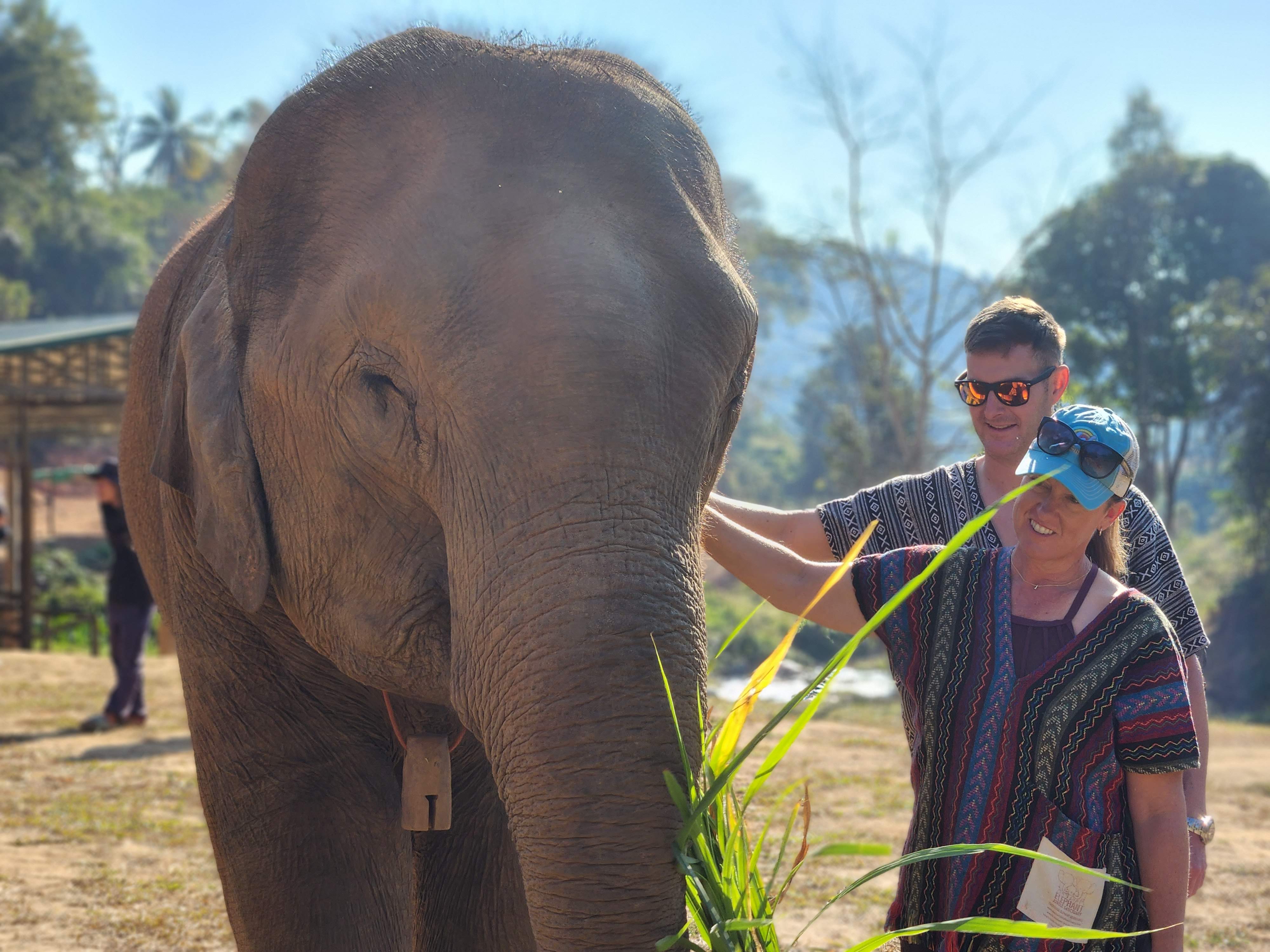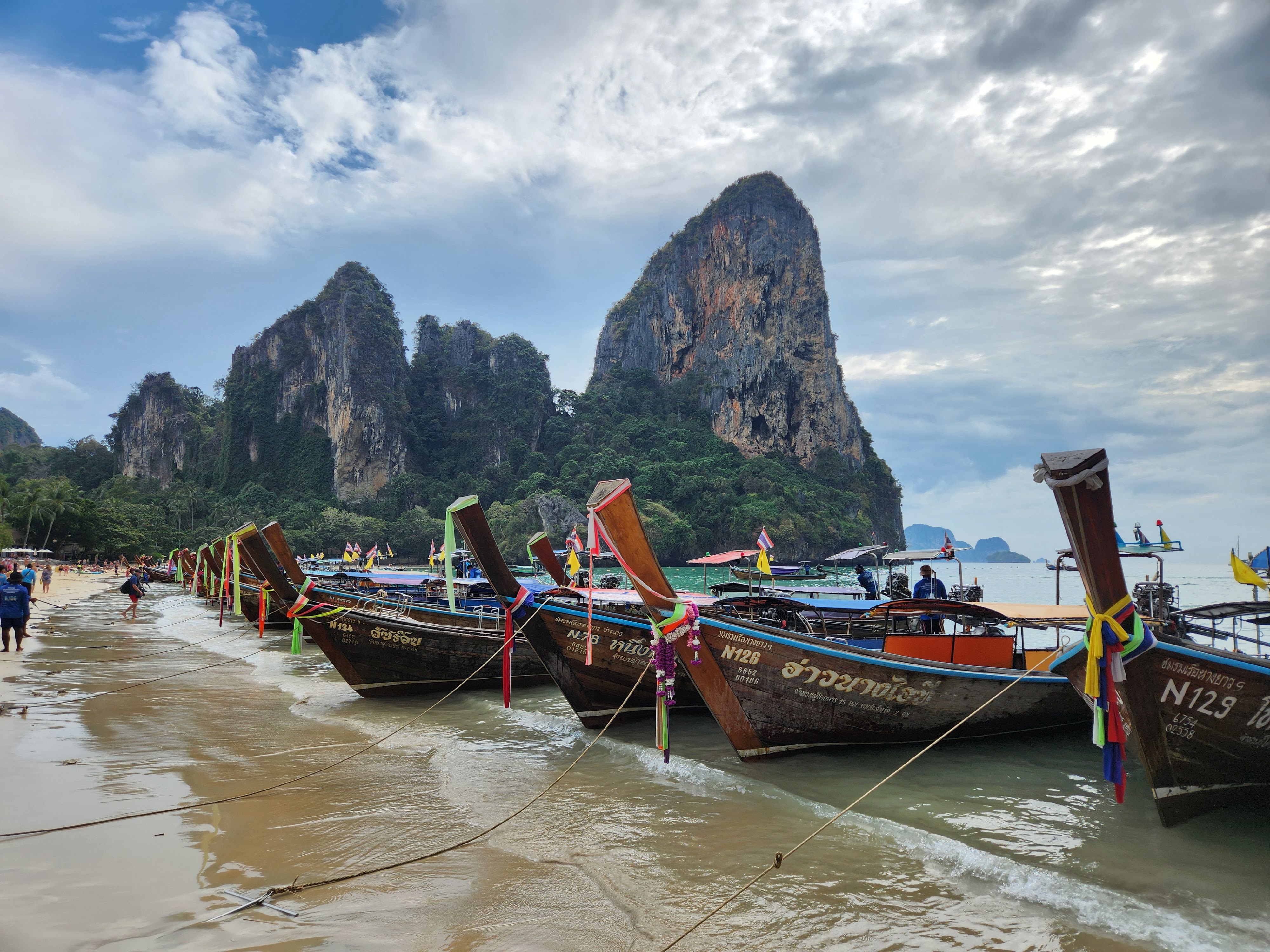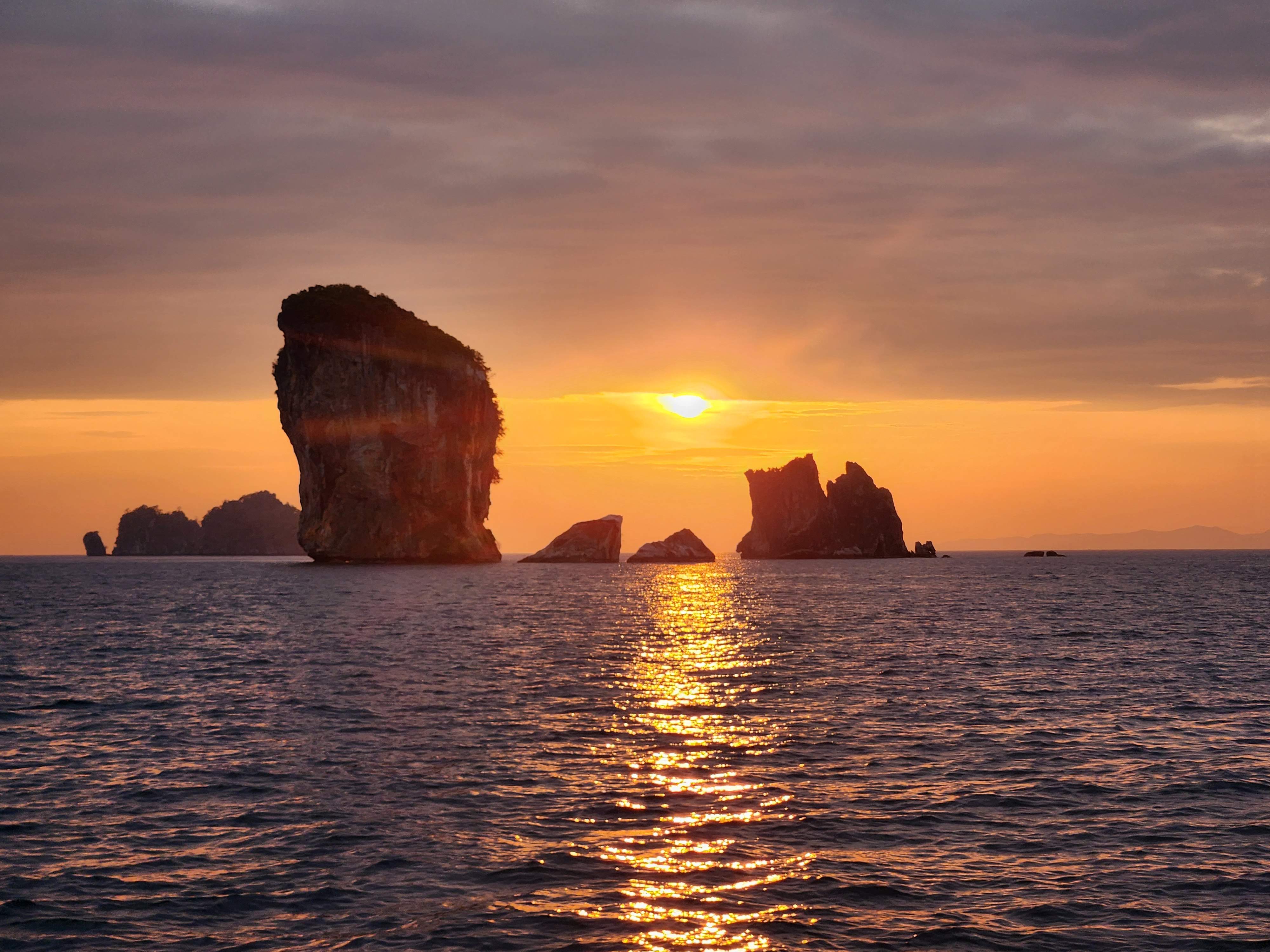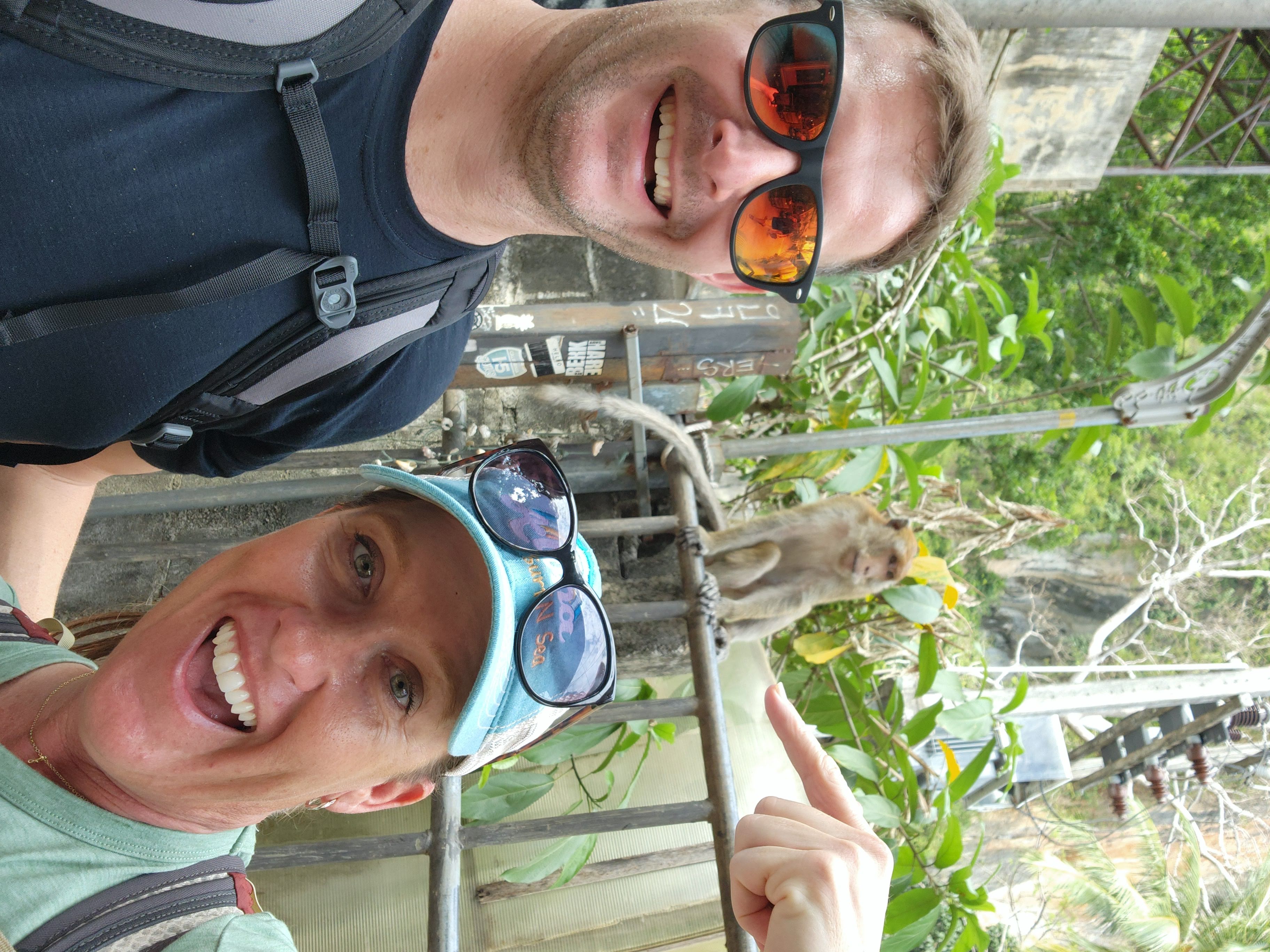
Today was Elephant Jungle Sanctuary day! A minibus from the sanctuary picked us up bright and early from our hotel and we piled into it, introducing ourselves as we climbed over people and made our way to the empty seats in the back. There were people from several different countries1 already on the bus and we were all headed about an hour and a half southwest of Chiang Mai to the sanctuary. The bus stopped about halfway along the route for everyone to have a 7-11 and toilet break before continuing on.
When we finally arrived at the Elephant Jungle Sanctuary facility in Mae Wang, we were instructed to make our way to the pavilion and to put on “traditional Karen wear.” Karen wear turned out to be colorful woven tunics named after the Karen tribes of the area, and they would protect us from getting muddy2 while we first fed and interacted with the elephants. We donned the tunics and then admired the herd of elephants from afar before sitting down to receive our briefing. We were given a brief informative session about Asian elephants- diet, habitat, anatomy, how they differ from African elephants, gestation, life expectancy, etc., that I of course ate up and did some follow up reading on later. The next part of the briefing focused on how to stay safe in our interactions with them. Finally it was time to make our way into their grassy pasture to feed and meet them!
Scott and I, along with some other participants, helped carry the tubs of fruit and vegetables down to the elephant shed where the herd was anxiously waiting to be fed. The elephants were standing somewhat patiently on their side of the post railing and we were allowed to hand feed them pieces of watermelon and squash. Some of them took it with their “finger” at the end of their trunk, while others would wrap their entire trunk around the slice to take it. They definitely had individual preferences.
All of the elephants at this sanctuary were all female and were rescues of some sort or another, rescued from riding camps, logging, or circuses. There was a baby elephant3, although at three years old, she was still quite a bit larger than a draft horse, and she was quite cheeky and full of sass, still learning how to interact politely and appropriately with her herd mates as well as humans. One of the elephants was pregnant and evidently she came to the sanctuary already pregnant4; in the world of elephant sanctuaries, allowing their herd to breed is frowned upon. One of the elephants seemed to be more anxious and high strung than the others and exhibited a stress behavior that I would have considered “weaving” if she was a horse, and it turns out that that’s exactly what she was doing.
When the food was all gone it was time for the elephants to wander back into their grassy pasture and graze on piles of plant stalks. They expertly picked up the stalks with their dextrous trunks and moved the plants to their mouth where they would spend time carefully chewing before reaching to grab the next.
We were then allowed to interact with the elephants and pet their shoulders as they ate. It was mesmerizing to be up next to them and to feel their thick skin and course and prickly guard hairs that cover their body. They went about their business of eating as we took turns petting them and posing for pictures with them, seemingly nonplussed by our existence. There were four adults and the baby, and with our small group size it was easy to take turns interacting with them.
The elephant that had been weaving while we were feeding her earlier didn’t seem as settled as the others and seemed more apprehensive of people. Each elephant had an assigned “mahout,” or caretaker, and I noticed that her mahout was on higher alert than any of the others. I was petting her and something about her body language subtly told me that she was displeased and I should back off, because unlike a horse that can be corrected, there would be no correcting a 5,000-8,000 lb Asian elephant if she decided she was irritated. I gave her a wide berth the rest of the day.
Scott happened to be near the baby elephant when she decided she was thirsty. He was able to get a video of her going over to the running water that was coming out of an irrigation pipe, take long draws of it through her trunk and then transfer it to her mouth to swallow.
The leaders then told us to head back up to the pavilion so that we could do the next activity. We then gathered round a table and were shown how to make vitamin and mineral enriched elephant treats to supplement their diet. We took turns mashing up the pellets, tamarind beans, and bananas with a huge wooden mortar and pestle, balling up the resulting mash, and then wrapping the mash balls with banana peels. We were then sent to change into our bathing suits.
The next interactive phase was a trip down into the river with the elephants, but first they lined up at the railing in their shed to devour the treat balls we had prepared for them. The baby had decided she was tired and needed a nap and had laid down along the railing. While down, her little trunk sneakily snaked its way into a bag of feed that the mahouts had brought down. They gave her a gentle correction and she decided her nap was over.
As soon as the treat balls were gone the elephants marched down to the river with the mahouts and with us trailing along. We were given bowls to splash the elephants and were told to be careful if they laid down in the river, not to get entangled with their legs, or else we would get squished when they went to stand up. Some got into the river and immediately dropped down to wet their bodies and others stayed standing. Water was flying everywhere as the group went about the business of dousing the elephants. When they were thoroughly wet, a group picture and water fight (with just humans) ensued as the mahouts guided the herd out of the river and up to the giant mud puddle for their mud bath.
The purpose of the mud bath was to act as a sun and bug protectant. Only about half of the group participated in this phase as it required wading barefoot into ankle deep squishy mud, taking handfuls of the mud and painting it by hand onto the elephants’ hides. (I had made sure that we didn’t have any open wounds on our legs or arms before agreeing to do it because there is no telling what sort of parasites or organisms might have been lurking in the quagmire.) The mahouts fed the elephants watermelon while we did the mud bath phase to help keep them quiet and still. When they were all thoroughly coated in a layer of mud they nimbly climbed up the embankment to exit the puddle and it was amazing how elegant and light on their feet they were; nothing about their gait or movement was clumsy or labored and was remarkably, actually quite the opposite.
We were sent back up the hill to the pavilion for a (clothed) group shower and to change back into our street clothes, and the mahouts and the elephants headed back into their pasture area to graze, browse, and forage among the bushes, trees, and shrubs. Elephants require 10% of their body weight a day in food, which is significantly higher than other large herbivores that only require 1-2%. I started thinking about the amount of land that it would take to sustain a herd of elephants and quickly had my mind blown.
The last phase of the experience was lunch and we were treated to a spread of traditional Thai dishes- massaman curry being one of them, that Scott actually liked. (He typically doesn’t like any sort of curries but during our time in Thailand he started to come around to them.) We sat around and talked to some of the other participants and I made friends with the sanctuary’s resident cat who helpfully cleaned my plate for me when I had finished. After lunch we were escorted back into our minibus, although this time with a different driver. Our driver was out to give us an authentic experience and drove like any good professional Thai driver worth his salt would- with aggressive use of the horn, taking wild chances to pass in curves and double yellows, and tailgating anyone in front of him who dared to be attempting to share the road with us. Thankfully I had packed some Tums5 and munched on them furiously and continuously throughout the whole ride back to our hotel.
Author’s note: I had to pick my battles here. Through my research prior to our trip, I had learned that truly ethical elephant sanctuaries are touch free and do not let participants touch the elephants, only watch them from a comfortable distance. This means no feeding, no bathing, etc. While there has now been a movement to end elephant riding in Thailand, it is still technically legal, and many unsavory companies still offer it. However, there are many other ways that elephants are exploited for the entertainment of humans: logging, circuses, and even the activities that we did with them such as the feeding, and bathing. Elephants don’t need us to bathe and mudbathe them, and in fact, would probably prefer we not.
Scott was dead set on being able to go to a place that allowed you to touch and interact with elephants, and I knew it was important to him. One of the hard lessons I feel like the universe has been trying to teach me over the last few years, is how to have my own personal set of animal care standards and ethics while at the same time accepting that while those standards and ethics may be recognized as industry or professional best practices, they might be not embraced by my loved ones, and how to exist, cope, and deal with the dissonance that that creates. As Scott likes to remind me, and I am trying to embrace, “you can be right, or you can have friends.”
But it is a fact that the interactions with the Asian elephants in captivity causes stress to them. I took comfort that the sanctuary we chose had mostly happy looking elephants that were acquired (I am hesitant to use the word rescued here) from lesser circumstances and now live a life that seems better than the one they had before. Perhaps if the interactions that visitors to these sanctuaries experience create awareness about elephant welfare, conservation, loss of habitat, and the risk of the species becoming endangered, then the existence of these sanctuaries can be justified, and that is what I had to tell myself to justify my own visit.
New Zealand, Germany, Brazil, and Italy ↩︎
A little ridiculous since part of our experience later in the day would be to literally give the elephants mud baths, but it added some flair to the experience and made for great photos. ↩︎
They are considered babies until about the age of 5 when they stop nursing ↩︎
Asian elephants have a gestation period of 18-22 months ↩︎
Or the Thai equivalent, Gaviscon, which annoyingly you had to go into an actual pharmacy to request from the pharmacist ↩︎


























